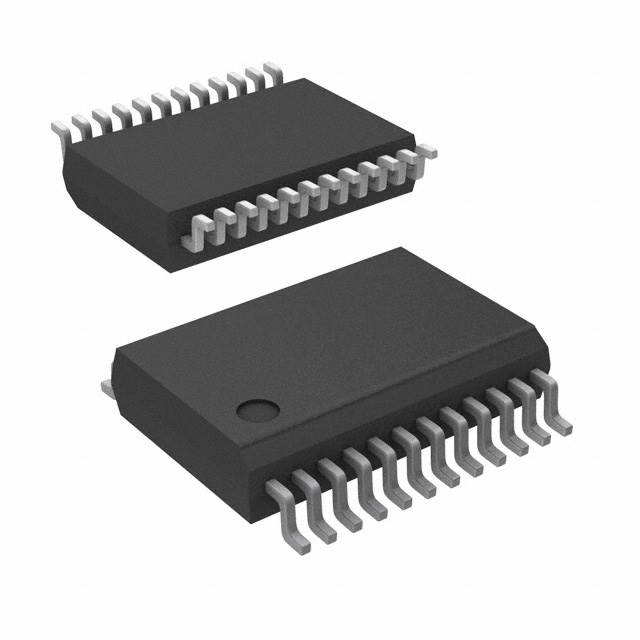TCA9555DBR
Manufacturer No:
TCA9555DBR
Manufacturer:
Description:
IC XPNDR 400KHZ I2C SMBUS 24SSOP
Datasheet:
Delivery:





Payment:




In Stock : 7083
Please send RFQ , we will respond immediately.









TCA9555DBR Specifications
-
TypeParameter
-
Supplier Device Package24-SSOP
-
Package / Case24-SSOP (0.209", 5.30mm Width)
-
Mounting TypeSurface Mount
-
Operating Temperature-40°C ~ 85°C
-
Voltage - Supply1.65V ~ 5.5V
-
Clock Frequency400 kHz
-
Current - Output Source/Sink10mA, 25mA
-
Output TypePush-Pull
-
FeaturesPOR
-
Interrupt OutputYes
-
InterfaceI²C, SMBus
-
Number of I/O16
-
DigiKey ProgrammableNot Verified
-
PackagingCut Tape (CT)
-
PackagingTape & Reel (TR)
-
Product StatusActive
-
Series-
The TCA9555DBR is a highly versatile integrated circuit chip that provides 16-bit input/output (IO) expander functionality. Some of its advantages and application scenarios include:1. GPIO Expansion: The TCA9555DBR allows expansion of GPIO pins, enabling the control of multiple devices and sensors from a single microcontroller. It provides an additional 16 programmable IO pins, which can be configured as either inputs or outputs.2. I2C Interface: The chip supports I2C communication protocol, allowing easy interfacing with microcontrollers and other devices using the standard two-wire bus. This simplifies the design process and reduces the number of pins required for communication.3. Input and Output Polarity Configuration: The TCA9555DBR allows individual configuration of input and output pins for polarity inversion. This flexibility enables compatibility with devices that require different logic levels or have varying signal polarities.4. Interrupt Functionality: The chip has interrupt pins that can be connected to microcontrollers, alerting them when a specific IO pin state changes. This feature offers efficient event-driven communication, reducing the need for continuous polling of IO pins.5. Low Power Consumption: The TCA9555DBR is designed for low power operation, consuming minimal current even when all IO pins are active. This makes it suitable for battery-powered applications to optimize power usage.6. Wide Operating Voltage Range: The chip supports a wide voltage range, typically from 1.65V to 5.5V. This versatility makes it compatible with a variety of microcontrollers and systems operating at different voltage levels.Application Scenarios:1. Industrial Automation: The TCA9555DBR can be used in industrial automation systems to expand the GPIO capabilities of microcontrollers. It allows control and monitoring of various sensors, actuators, and devices, enhancing the overall functionality and flexibility of the system.2. Home Automation: In home automation applications, the chip can be employed to expand the IO capabilities of microcontrollers or central control systems. This enables the control of lighting, HVAC systems, security sensors, and other home devices from a central interface.3. Medical Devices: The TCA9555DBR can be utilized in medical devices to enable GPIO expansion for sensor inputs, actuator control, or communication with other modules. It enables easy integration of additional functionality and aids in the design of compact and efficient medical devices.4. Consumer Electronics: The chip finds applications in consumer electronics products, such as smart home devices, appliances, or wearable gadgets. It can be used to control various inputs and outputs, enabling efficient and flexible user interfaces.5. Internet of Things (IoT): The TCA9555DBR is suitable for IoT devices that require expanded IO capabilities within constrained resources. It can be used to connect and control a wide range of sensors, actuators, and peripherals in an IoT network, simplifying the design and enhancing the connectivity options.Overall, the TCA9555DBR integrated circuit chip offers numerous advantages and can be applied in various scenarios where GPIO expansion, I2C communication, low power consumption, and flexibility in input/output configuration are required.
TCA9555DBR Relevant information
-
VSC056KM
Texas Instruments -
TCA9539QPWRQ1
Analog Devices Inc. -
PCAL9538ABSHP
Analog Devices Inc./Maxim Integrated -
PCA8574APW,112
Renesas -
PCF8574ADWG4
Analog Devices Inc./Maxim Integrated -
PCA9536D,118
National Semiconductor -
MAX7311EUG
Ampleon USA Inc. -
PCA9554BS,118
Texas Instruments -
PCF8574T/3,512
National Semiconductor -
PCA9554DB,118
Burr Brown







